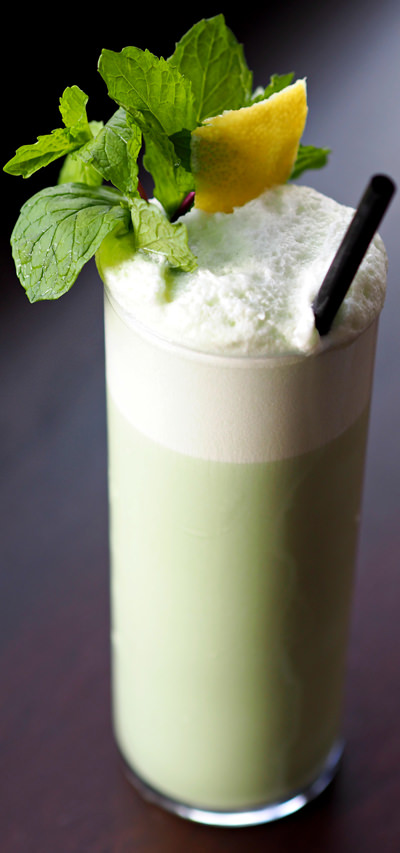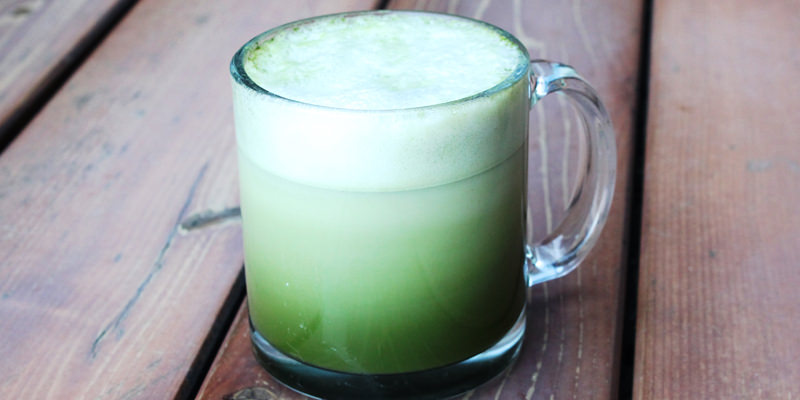
In the most basic terms, matcha is a special kind of green tea. It’s also quickly becoming a popular cocktail ingredient at bars across the country.
“Unlike most teas in which the leaves are steeped in hot water and then strained out, with matcha you are actually drinking the leaves,” says Mike Lu of Estrellon in Madison, Wisconsin. The tea leaves are dried, aged, turned into a powder and made into a solution, traditionally by mixing about a teaspoon of matcha powder with a third a cup of hot water (heated to less than a boil), which is then whisked with a bamboo brush until it froths.
Generally, matcha is used in cocktails in its powder form due to its strong, bold, earthy, and bitter flavors. “As a powder, it is so easily malleable that it works well as infusions with alcohol, or in syrups for sweeteners,” says Lu. You can still feel healthy while you get drunk, because it also contains caffeine and is well-known for its health benefits. “Who wouldn’t want a cocktail that makes you feel great, and is (kind of) good for you?”
Matcha is a delicate, finely ground powder made from shade-grown green tea leaves. “The process originated in China, and it requires particular farming practices and rituals- the whole process starts several weeks before harvest and takes up to twenty days to get the fine, bright green talc we use,” says Spirit Guide Nandini Khaund from Cindy’s in Chicago.
First, they cover the tea bushes to slow down growth and stimulate chlorophyll levels, resulting in a richer green color and an increase in amino acids. “Each bud is handpicked, unfurled and laid out to dry.” Then it is de-stemmed, de-veined, and slowly ground at just the right temperature in order not to lose aroma. “It takes an hour to get 30 grams of matcha.”
For centuries it was used in rituals and is gaining in popularity in the cocktail world because of its flavor and health benefits. “It is high in antioxidants and wakes you up in a clear-headed way.”
 One cup of matcha has the power of ten cups of mere mortal green tea. “It boosts metabolism, it is rich in vitamins and minerals, it lowers cholesterol, and it has the highest natural concentration of a unique form of antioxidants (the catechin EGCg)- which may be a champion in fighting cancer,” says Khaund. “Also, it is a very elegant buzz.”
One cup of matcha has the power of ten cups of mere mortal green tea. “It boosts metabolism, it is rich in vitamins and minerals, it lowers cholesterol, and it has the highest natural concentration of a unique form of antioxidants (the catechin EGCg)- which may be a champion in fighting cancer,” says Khaund. “Also, it is a very elegant buzz.”
Bartenders enjoy working with it because it’s incredibly flexible, so it works well within the sweet and savory range of flavors. “I find it works best with citrus flavors (lime, lemon, or its japanese counterpar yuzu) or egg whites,” says Lu. “The flavor is earthy and slightly bitter, and it has a really cool color,” says Khaund.
Lu uses it in a cocktail called “86 Lu”, it’s a variant on the Ramos gin fizz, containing lemon, lime, cream, egg white, vodka, soda, and matcha powder.
Khaund says that when you’re done with cocktails, matcha is also a great baking ingredient. “Matcha and chocolate are great together.” The green tea complements nutty flavors such as almond. “But, it can withstand pairings with fruit as well.” She adds, “Banana-matcha smoothies are pretty great too.”
She makes a cocktail using the highest quality matcha from the Shizuoka prefecture in Japan. “It’s the ‘first flush’, the first spring leaves from the top of the bush that have received most of the plant’s energy, a very high grade matcha.”
First, she prepares a matcha honey almond milk latte. “The addition of Lazzaroni Amaretto provides the ‘almond/lemon cookie’ hint while the Tanqueray Old Tom gin elevates it with delicate malt and floral botanical notes.”
Khaund believes that a good matcha is totally worth it. “I wish I could say it wasn’t, but it is not cheap. The flavor is much more nuanced- it tastes as fragrantly green as the amount of green you have to spend to get it.”

